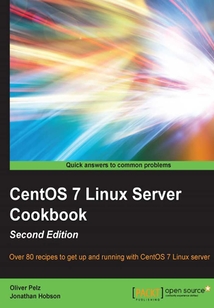目錄(136章)
倒序
- 封面
- 版權(quán)頁
- Credits
- About the Authors
- About the Reviewer
- www.PacktPub.com
- Support files eBooks discount offers and more
- Preface
- What this book covers
- What you need for this book
- Who this book is for
- Sections
- Conventions
- Reader feedback
- Customer support
- Chapter 1. Installing CentOS
- Introduction
- Downloading CentOS and confirming the checksum on Windows or OS X
- Creating USB installation media on Windows or OS X
- Performing an installation of CentOS using the graphical installer
- Running a netinstall over HTTP
- Installing CentOS 7 using a kickstart file
- Getting started and customising the boot loader
- Troubleshooting the system in rescue mode
- Updating the installation and enhancing the minimal install with additional administration and development tools
- Chapter 2. Configuring the System
- Introduction
- Navigating text files with less
- Introduction to Vim
- Speaking the right language
- Synchronizing the system clock with NTP and the chrony suite
- Setting your hostname and resolving the network
- Building a static network connection
- Becoming a superuser
- Customizing your system banners and messages
- Priming the kernel
- Chapter 3. Managing the System
- Introduction
- Knowing and managing your background services
- Troubleshooting background services
- Tracking system resources with journald
- Configuring journald to make it persistent
- Managing users and their groups
- Scheduling tasks with cron
- Synchronizing files and doing more with rsync
- Maintaining backups and taking snapshots
- Monitoring important server infrastructure
- Taking control with GIT and Subversion
- Chapter 4. Managing Packages with YUM
- Introduction
- Using YUM to update the system
- Using YUM to search for packages
- Using YUM to install packages
- Using YUM to remove packages
- Keeping YUM clean and tidy
- Knowing your priorities
- Using a third-party repository
- Creating a YUM repository
- Working with the RPM package manager
- Chapter 5. Administering the Filesystem
- Introduction
- Creating a virtual block device
- Formatting and mounting a filesystem
- Using disk quotas
- Maintaining a filesystem
- Extending the capacity of the filesystem
- Chapter 6. Providing Security
- Introduction
- Locking down remote access and hardening SSH
- Installing and configuring fail2ban
- Working with a firewall
- Forging the firewall rules by example
- Generating self-signed certificates
- Using secure alternatives to FTP
- Chapter 7. Building a Network
- Introduction
- Printing with CUPS
- Running a DHCP server
- Using WebDAV for file sharing
- Installing and configuring NFS
- Working with NFS
- Securely sharing resources with Samba
- Chapter 8. Working with FTP
- Introduction
- Installing and configuring the FTP service
- Working with virtual FTP users
- Customizing the FTP service
- Troubleshooting users and file transfers
- Chapter 9. Working with Domains
- Introduction
- Installing and configuring a caching-only nameserver
- Setting up an authoritative-only DNS server
- Creating an integrated nameserver solution
- Populating the domain
- Building a secondary (slave) DNS server
- Chapter 10. Working with Databases
- Introduction
- Installing a MariaDB database server
- Managing a MariaDB database
- Allowing remote access to a MariaDB server
- Installing a PostgreSQL server and managing a database
- Configuring remote access to PostgreSQL
- Installing phpMyAdmin and phpPgAdmin
- Chapter 11. Providing Mail Services
- Introduction
- Configuring a domain-wide mail service with Postfix
- Working with Postfix
- Delivering the mail with Dovecot
- Using Fetchmail
- Chapter 12. Providing Web Services
- Introduction
- Installing Apache and serving web pages
- Enabling system users and building publishing directories
- Implementing name-based hosting
- Implementing CGI with Perl and Ruby
- Installing configuring and testing PHP
- Securing Apache
- Setting up HTTPS with Secure Sockets Layer (SSL)
- Chapter 13. Operating System-Level Virtualization
- Introduction
- Installing and configuring Docker
- Downloading an image and running a container
- Creating your own images from Dockerfiles and uploading to Docker Hub
- Setting up and working with a private Docker registry
- Chapter 14. Working with SELinux
- Introduction
- Installing and configuring important SELinux tools
- Working with SELinux security contexts
- Working with policies
- Troubleshooting SELinux
- Chapter 15. Monitoring IT Infrastructure
- Introduction
- Installing and configuring Nagios Core
- Setting up NRPE on remote client hosts
- Monitoring important remote system metrics
- Index 更新時間:2021-07-23 14:29:12
推薦閱讀
- MySQL數(shù)據(jù)庫管理實戰(zhàn)
- Visual FoxPro 程序設(shè)計
- 用Flutter極速構(gòu)建原生應(yīng)用
- 微信小程序項目開發(fā)實戰(zhàn)
- Java EE 8 Application Development
- HTML5開發(fā)精要與實例詳解
- Instant Debian:Build a Web Server
- JavaScript+jQuery網(wǎng)頁特效設(shè)計任務(wù)驅(qū)動教程
- 零基礎(chǔ)學(xué)Python編程(少兒趣味版)
- 并行編程方法與優(yōu)化實踐
- Mastering Gephi Network Visualization
- Python第三方庫開發(fā)應(yīng)用實戰(zhàn)
- Mastering PostgreSQL 11(Second Edition)
- 開發(fā)者測試
- Python程序設(shè)計案例教程
- Getting Started with Phalcon
- AngularJS Deployment Essentials
- Applied Supervised Learning with Python
- Visual Basic從入門到精通(第5版)
- Mastering OpenVPN
- C++趣味編程及算法入門
- Java設(shè)計模式(第2版)
- Go語言從入門到項目實踐(超值版)
- Blender Cycles:Materials and Textures Cookbook(Third Edition)
- Visual Basic程序設(shè)計
- Arduino: Building exciting LED based projects and espionage devices
- Visual C#.NET程序設(shè)計教程(第2版)
- Scratch 3.0少兒游戲趣味編程2
- Akka實戰(zhàn):快速構(gòu)建高可用分布式應(yīng)用
- Nuclio實戰(zhàn)及源碼分析:基于Kubernetes的Serverless FaaS平臺


